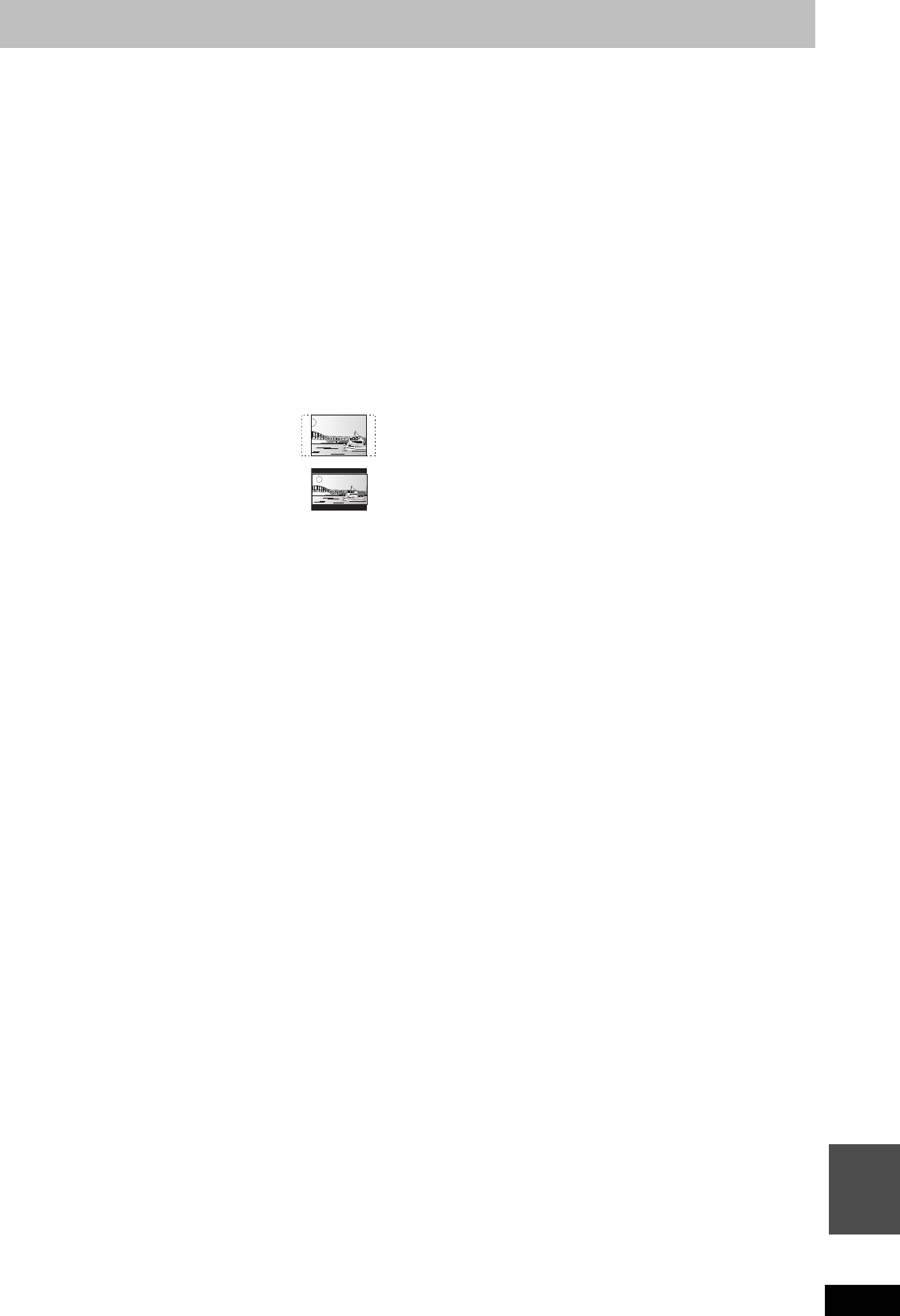
119
RQT9434
Reference
LPCM (Linear PCM)
These are uncompressed digital signals, similar to those found on
CDs.
MPEG2 (Moving Picture Experts Group)
A standard for efficiently compressing and expanding colour video.
MPEG2 is a compression standard used for DVD and satellite based
digital broadcasting.
MPEG-4 AVC/H.264
A standard for efficiently compressing and expanding colour video.
MPEG-4 AVC/H.264 is an encoding method used for recording of
the high definition videos.
MP3 (MPEG Audio Layer 3)
An audio compression method that compresses audio to
approximately one tenth of its size without any considerable loss of
audio quality.
Pan&Scan/Letterbox
In general, BD-Video and DVD-Video are produced with the
intention that they be viewed on a widescreen television (16:9
aspect ratio), so images often don’t fit regular (4:3 aspect ratio)
televisions. Two styles of picture, “Pan & Scan” and “Letterbox”, deal
with this problem.
Progressive/Interlace
Interlace is a conventional image signal that displays the image in 2
phases by splitting the display into odd and even scans.
Progressive will display whole image in 1 scan. Therefore, it will give
high definition image without flickering compared with interlace.
Protection
You can prevent accidental deletion by setting writing protection or
deletion protection.
RGB
This refers to the three primary colours of light, red (R), green (G),
and blue (B) and also the method of producing video that uses them.
By dividing the video signal into the three colours for transmission,
noise is reduced for even higher quality images.
Router
Distinguishes the IP address assigned to each device, such as the
PC, and relays the flow of data within the network.
Sampling frequency
Sampling is the process of converting the heights of sound wave
(analog signal) samples taken at set periods into digits (digital
encoding). Sampling frequency is the number of samples taken per
second, so larger numbers mean more faithful reproduction of the
original sound.
Signal Quality
This is the guide for checking the aerial direction. The numbered
values displayed do not indicate the strength of the signal, but the
quality of the signal (the signal to noise ratio, or “S/N”). The channels
you can receive are affected by weather conditions, seasons, time
(day/night), region, length of the cable that is connected to the aerial,
etc.
Subnet mask
Enables efficient network use. A set of numbers which identify which
part of the IP address allocated to every device connected to the
router is the network portion.
Thumbnail
This refers to a miniature representation of a picture used to display
multiple pictures in the form of a list.
Transponder
The signals of a broadcasting station are received by a transponder
on a satellite. The transponder converts them to frequencies and
sends them to satellite dishes near the ground. A transponder can
broadcast several TV and radio programmes or data in parallel.
x.v.Colour
TM
x.v.Colour
TM
is a name for devices that are compatible with the
xvYCC format, an international standard for expanded colour in
motion pictures, and that follow the rules for signal transmission.
You can enjoy vivid colours of wider colour ranges for a more
realistic picture when connected to a TV that supports the
x.v.Colour
TM
with HDMI cable.
1080i
In one high definition image, 1080 (1125) alternating scan lines pass
every 1/50th of a second to create an interlace image. Because
1080i (1125i) more than doubles current television broadcasts of
480i (525i), the detail is much clearer and creates a more realistic
and rich image.
1080p
In one high definition image, 1080 (1125) scan lines pass at the
same time every 1/50
th
of a second to create a progressive image.
Since progressive video does not alternate scan lines like interlace,
there is a minimal amount of screen flicker.
24p
This is a progressive image recorded at a rate of 24 frames per
second.
720p
In one high definition image, 720 (750) scan lines pass at the same
time every 1/50
th
of a second to create a progressive image. Since
progressive video does not alternate scan lines like interlace, there
is a minimal amount of screen flicker.
Pan & Scan: The sides are cut off so the picture
fills the screen.
Letterbox: Black bands appear at the top and
bottom of the picture so the picture
itself appears in an aspect ratio of
16:9.
DMRBS850&750EG-RQT9434-L_eng.book 119 ページ 2010年1月14日 木曜日 午後4時21分


















